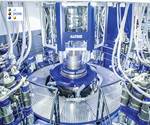Productivity & Profitability ‘Turbo' Charged At Young, Growing Film Processor
Polymer Film & Bag adds extrusion capacity and new technology to make its two-year-old processing business more efficient.
Polymer Packaging started its Polymer Film & Bag (PF&B) division just three years ago on the premise that consolidation in the film-extrusion business had created a need for a high-end film processor that was fast, nimble, and customer-centric. The premise seems to have been sound; in roughly two years PF&B has grown into a film processing operation with 50 million lb of capacity operating out of a 100,000 ft2 plant in Massillon, Ohio, also the home of its Polymer Packaging sister company.
Since it opened in late 2019, PF&B has installed five blown film lines from Windmoeller & Hoelscher—a combination of three Varex lines and two Optimex systems. All run three-layer films for retail and institutional food and beverage, agricultural/lawn and garden, and general-purpose applications. PF&B expects to hit 50 million lb of capacity by year end, when its third Optimex line is fired up.
From its inception, PF&B availed itself of technology aimed at making its operation as efficient as possible. It’s first Varex line, for instance, was W&H’s Varex 2 system equipped with the supplier’s Turboclean technology, which is said to reduce the time it takes between full job and format changeovers from 30 min to roughly 12 min. It’s most recently installed line is a 2800-mm Varex II equipped with W&H’s Turbostart automated line start and stop system.
Turbostart is a novel automated system for starting, stopping and restarting blown film lines that simplifies the processes that are necessary for everyday production. Turbostart was launched at the K 2019 show in Düsseldorf, where it was demonstrated on a production-scale five-layer blown film line three times a day. The technology is available not only on new lines but also for retrofit.

Left to right, in front of their newest W&H line are Polymer Film & Bag’s Eric Howard, div. president; Larry Lanham, owner/CEO; Mike Pearce, v.p. operations; and Chris Thomazin, group president. (Photo: Polymer Film & Bag)
With Turbostart, the entire startup process can now be executed by pushing a handful of buttons on W&H’s Procontrol terminal, as opposed to hopping through several different screens and manually adjusting a variety of different settings as the machine starts. This is possible due to Turbostart’s ability to automatically ramp up and move all machine components into a state ready for production.
When it is time to stop the line—to change screens or clean die lips, for example—the Turbostop function can be initiated with the press of one button to bring all components of the machine to the home position, and slowly ramp down the extrusion system to a controlled stop. With Turbostart, operators no longer have to climb stairs or handle knives, since the Turbostart not only cuts air out of the collapsed tube but also inserts tube-slitting knives automatically at the secondary nip or draw unit, making the edge-slit tube ready for web separation.
With so much being automated, the operator is required only to tie the new film onto the existing film left threaded through the line, separate the film at the winder after slitting, and perform a roll change to bring the line into production.
Eric Howard, PF&B president, says installation and commissioning were on time, smooth and as expected. What did surprise him, however, was the performance of the Turbostart system, which was customized to accommodate the web’s gussets. “We didn’t foresee the full effect of Turbostart,” he notes. “It’s cut down on downtime by fivefold. Now, regardless of the size of material, unscheduled downtime events last only around 15 minutes.”
Howard adds, “We use Turbostart as a tool to complement Easy Change and were amazed that Easy Change can recover parameters from the previous run and use those as if the machine had been running the whole time. The system is adding 10-15 hr per week into our production schedule, which equates to roughly three-quarters of a million dollars per line per year. It’s savvy.”
Easy Change is another W&H innovation. It automates many of the steps that operators must take when making a product change, among them automatic adjustment of vacuum loaders, gravimetric hoppers, extruder speeds, die temperatures, bubble-cage diameter and height adjustments, line speed and web tension.
PF&B has also seen that Turbostart extends both the labor force and opportunity for growth. Howard explains, “The time to train and bring an operator up to an effective level has been reduced by 10 times. That means that we’re saving a lot of money on training and also on scrap that would normally accumulate while an operator is learning the ropes. That’s a lot of savings per operator per year. This is time we can now use to focus on sales.” The company has ordered Turbostart retrofits for its two existing Varex lines.
Polymer Film & Bag is about to start a new expansion phase, which will include adding another two or three extrusion lines in the existing facility. The second phase will allow for another 105,000-ft2 expansion that will accommodate up to an additional 10 blown film lines, totaling 18 at this site.
Related Content
How to Effectively Reduce Costs with Smart Auxiliaries Technology
As drying, blending and conveying technologies grow more sophisticated, they offer processors great opportunities to reduce cost through better energy efficiency, smaller equipment footprints, reduced scrap and quicker changeovers. Increased throughput and better utilization of primary processing equipment and manpower are the results.
Read MoreFollow These Tips to Fire Up Your Cold Blown Film Line
Firing up a cold blown-film line after a shutdown involves multiple pieces of equipment that all interact. Here’s a look at those components individually and some best practices on how to get your line up and running as quickly and safely as possible.
Read MoreRoll Cooling: Understand the Three Heat-Transfer Processes
Designing cooling rolls is complex, tedious and requires a lot of inputs. Getting it wrong may have a dramatic impact on productivity.
Read MoreMaterials Suppliers Team on PFAS-Free Solutions
Baerlocher PFAS-fee process aid passes muster in resin manufacturer’s testing on production-sized blown film line.
Read MoreRead Next
Not Running, But Still Pushing Technology Envelope in Film Extrusion
W&H sees options in retrofitting game-changing quick-switch technology.
Read MoreK 2016 Extrusion: Speed, Versatility Rule the Day at K
Shorter product runs mean frequent product changeovers for processors, and suppliers responded to these trends across all extrusion technologies.
Read MorePackaging Converter Launches Film-Extrusion Business
Polymer Film & Bag Inc. will start with three-layer capacity of more than 20 million lb/yr, with additional expansion plans already firmed up.
Read More






















